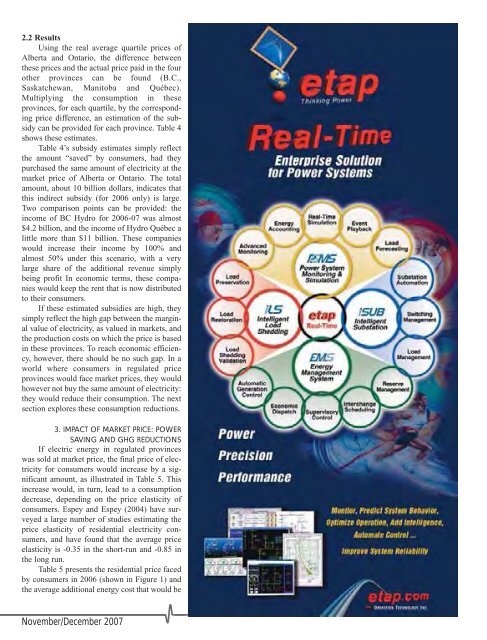in this issue - Electricity Today Magazine
in this issue - Electricity Today Magazine
in this issue - Electricity Today Magazine
You also want an ePaper? Increase the reach of your titles
YUMPU automatically turns print PDFs into web optimized ePapers that Google loves.
2.2 Results<br />
Us<strong>in</strong>g the real average quartile prices of<br />
Alberta and Ontario, the difference between<br />
these prices and the actual price paid <strong>in</strong> the four<br />
other prov<strong>in</strong>ces can be found (B.C.,<br />
Saskatchewan, Manitoba and Québec).<br />
Multiply<strong>in</strong>g the consumption <strong>in</strong> these<br />
prov<strong>in</strong>ces, for each quartile, by the correspond<strong>in</strong>g<br />
price difference, an estimation of the subsidy<br />
can be provided for each prov<strong>in</strong>ce. Table 4<br />
shows these estimates.<br />
Table 4’s subsidy estimates simply reflect<br />
the amount “saved” by consumers, had they<br />
purchased the same amount of electricity at the<br />
market price of Alberta or Ontario. The total<br />
amount, about 10 billion dollars, <strong>in</strong>dicates that<br />
<strong>this</strong> <strong>in</strong>direct subsidy (for 2006 only) is large.<br />
Two comparison po<strong>in</strong>ts can be provided: the<br />
<strong>in</strong>come of BC Hydro for 2006-07 was almost<br />
$4.2 billion, and the <strong>in</strong>come of Hydro Québec a<br />
little more than $11 billion. These companies<br />
would <strong>in</strong>crease their <strong>in</strong>come by 100% and<br />
almost 50% under <strong>this</strong> scenario, with a very<br />
large share of the additional revenue simply<br />
be<strong>in</strong>g profit In economic terms, these companies<br />
would keep the rent that is now distributed<br />
to their consumers.<br />
If these estimated subsidies are high, they<br />
simply reflect the high gap between the marg<strong>in</strong>al<br />
value of electricity, as valued <strong>in</strong> markets, and<br />
the production costs on which the price is based<br />
<strong>in</strong> these prov<strong>in</strong>ces. To reach economic efficiency,<br />
however, there should be no such gap. In a<br />
world where consumers <strong>in</strong> regulated price<br />
prov<strong>in</strong>ces would face market prices, they would<br />
however not buy the same amount of electricity:<br />
they would reduce their consumption. The next<br />
section explores these consumption reductions.<br />
3. IMPACT OF MARKET PRICE: POWER<br />
SAVING AND GHG REDUCTIONS<br />
If electric energy <strong>in</strong> regulated prov<strong>in</strong>ces<br />
was sold at market price, the f<strong>in</strong>al price of electricity<br />
for consumers would <strong>in</strong>crease by a significant<br />
amount, as illustrated <strong>in</strong> Table 5. This<br />
<strong>in</strong>crease would, <strong>in</strong> turn, lead to a consumption<br />
decrease, depend<strong>in</strong>g on the price elasticity of<br />
consumers. Espey and Espey (2004) have surveyed<br />
a large number of studies estimat<strong>in</strong>g the<br />
price elasticity of residential electricity consumers,<br />
and have found that the average price<br />
elasticity is -0.35 <strong>in</strong> the short-run and -0.85 <strong>in</strong><br />
the long run.<br />
Table 5 presents the residential price faced<br />
by consumers <strong>in</strong> 2006 (shown <strong>in</strong> Figure 1) and<br />
the average additional energy cost that would be<br />
November/December 2007












